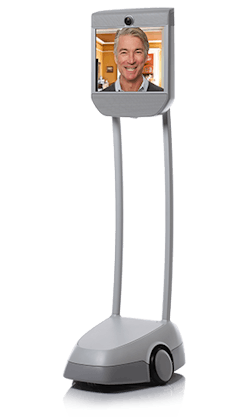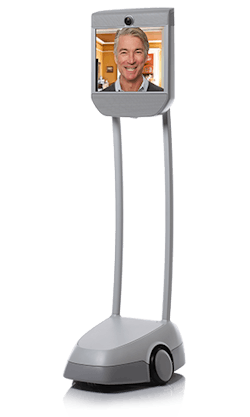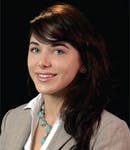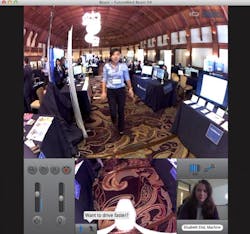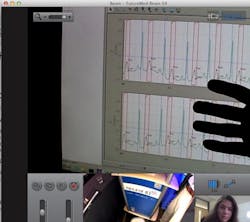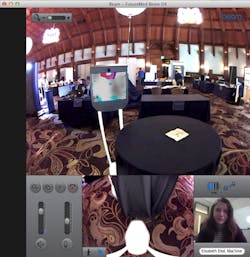Telepresence robot gives me wicked case of the giggles
The ease with which I could interact and even pester people at this event through the Beam soon reduced me to giggles, exacerbated by the fact that my uncontrolled tittering was being beamed rather loudly into a posh conference hall 2,400 miles away ... making bystanders turn their heads and watch with bewilderment and amusement.
Here's a screenshot of the telepresence interface of the Beam I'm steering down one of the isles at FutureMed. In front of me, Emily Li of Suitable Technologies looks on (probably in horror) at how giddy I've become (lower right) from using her company's device. Lower right is also what's projected onto the face of the Beam.
First, my esteemed colleague Bill Wong (and a fellow editor on Machine Design's sister publication, Electronic Design) connected me with Suitable Technologies. Next, I downloaded to my laptop the software needed to control a Beam telepresence device and remotely took possession of one of the Beams (look out, people!) in the FutureMed conference hall.
|
Photo Gallery: How to use a telepresence robot |
Then, after Emily Li, an enterprise sales associate with Suitable set me up, I rolled my Beam out of her booth and to another booth at the show — that of Neural ID. After being told a few times that I was very loud (and I'm normally admonished for speaking too softly) I turned Beam's microphone down and chatted with Neural ID's PhD Tyson Thomas and computer scientist Karl Geiger about their pattern-recognition software.
Neural ID's technology is a topic for another day (on medicaldesign.com, where we'll post details) but in short, their pattern-ID software lets scientists and doctors see patterms in unstructured data faster with several learn functions. In fact, a company we regularly cover, National Instuments, has partnered with Neural ID. "Neural ID’s CURE technology and NI LabVIEW software enable intelligent solutions for this complex challenge that offer new capabilities for solving computer-intensive and large data set problems," says Thomas in a recent case study detailing how Neural ID’s CURE technology works with NI LabVIEW to track anomalies during the testing and inspection of CT images.
After another lap around FutureMed, I finally bumped into Bill Wong (or at least, his telepresence on another Beam). We were shooed away from a booth for being too distracting, so steered our Beams to a courtesy table where we parked and chatted before Bill led me to a table showcasing a 3D-printing technology.
In coming days I'll share some of the technical details about the Beam itself as well as some of its applications. In the mean time, please check out Bill's detailed report about the Beam's features and potential.
About the Author
Elisabeth Eitel Blog
Elisabeth is Senior Editor of Machine Design magazine. She has a B.S. in Mechanical Engineering from Fenn College at Cleveland State University. Over the last decade, Elisabeth has worked as a technical writer — most recently as Chief Editor of Motion System Design magazine.
